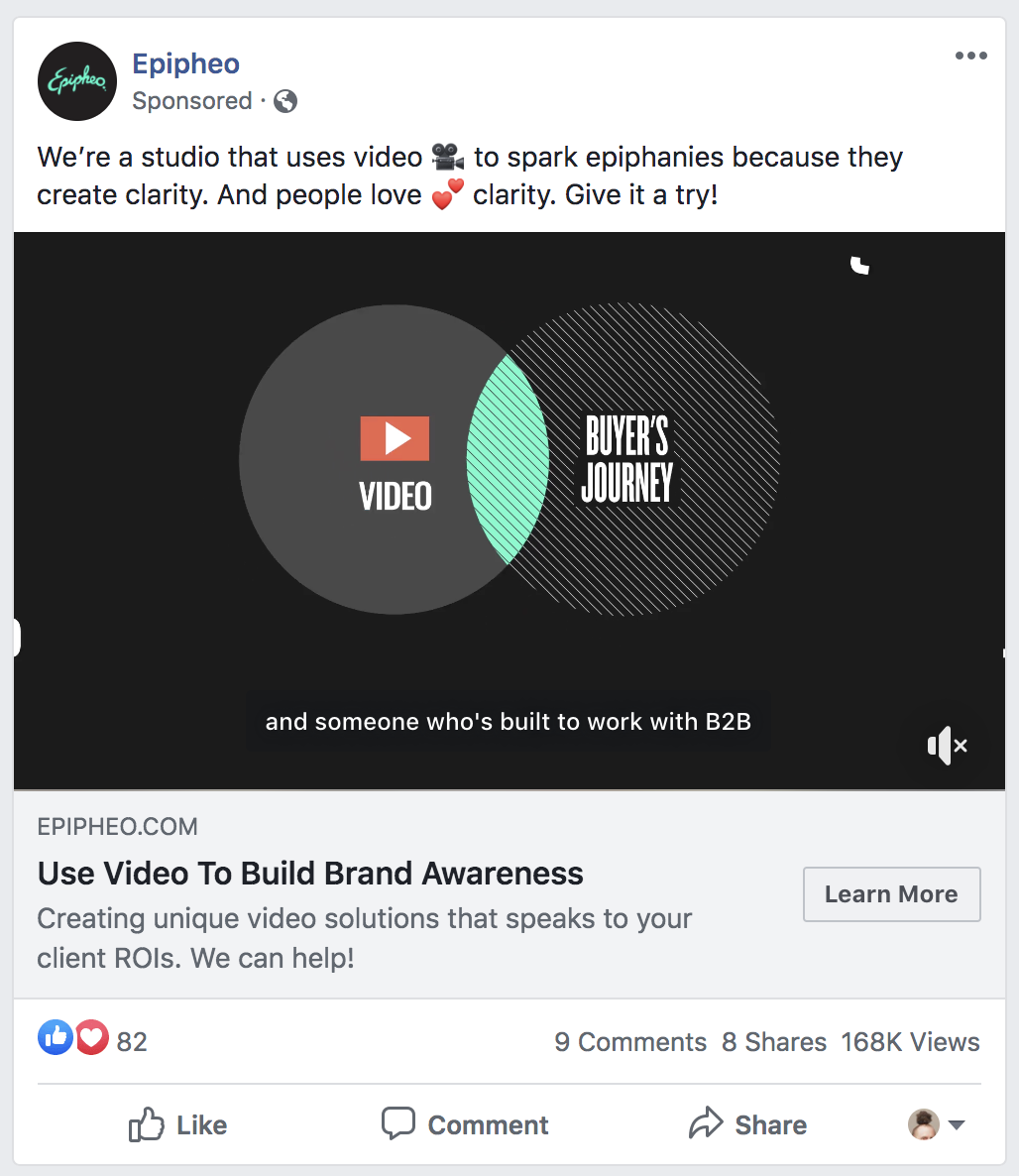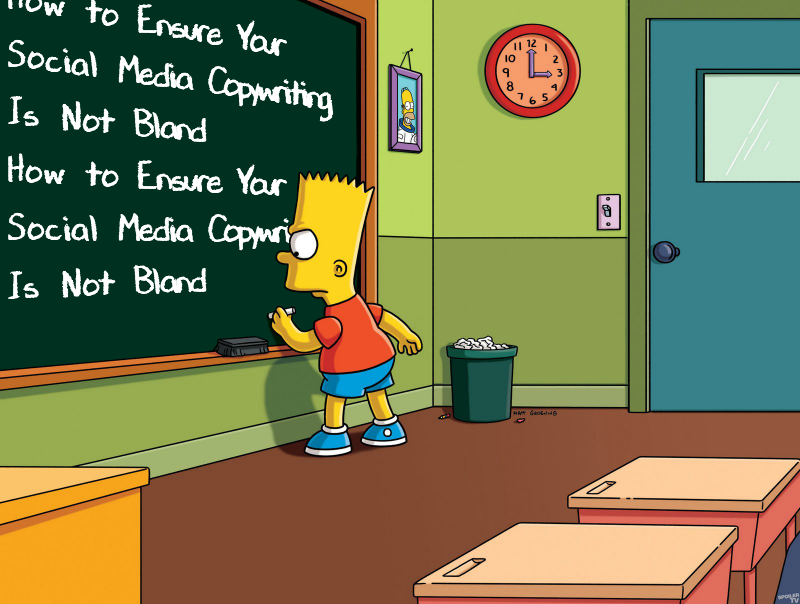Bland is just fine. It’s not bland’s fault for being forgettable. But bland has a place, so what else can we do to write impactful content on social media?
Here are some zesty suggestions about social media copywriting:
- Boost your authenticity by prompting employees to share in their own words.
- OAR: know your objectives, audience, and relevant information.
- Consider multimedia opportunities to accompany your messaging.
- When voicing company accounts on social media, play the role and get into character.
- As an individual company writer, continue your education and share personal insights.
1. Boosting copywriting authenticity with employee advocacy
Bland writing is okay, meaning it’s permissible but also mediocre.
For brands trying to convey a unique and engaging sentiment to their audiences however, “bland” can mean that your copywriting is formulaic (like a lazy robot penned it), inauthentic (anonymous and not featuring actual employees), and just outright uninformative.
Every writer has a rule or two, maybe a heuristic, or a mantra — even if such a guideline is to eschew rules altogether. “Style must precede content” someone once told me, which is a fun inversion of the expected hierarchy, in effect relegating data to narrative.
As a child of postmodernism, I can dig this, but let’s be honest: “experiential nonfiction” (or just fiction) is not a sufficient best practice for social media copywriting; sometimes we need to be objective!
Unless however, your social media copywriting is substantially supplemented by employee advocacy, in which case: let employees share their workplace experiences in their own words to no end!
The most accessible and abundant way to ensure that your social media copywriting is not bland is to in effect: democratize it through employee advocacy. Users will share their own content associated with their employer and company brand, and do so in their own genuine voice.
Copywriters are here to stay, but leveraging employee advocacy as a supplement to official brand messaging on social media is the best way to stand out.
2. Objectives, Audience, and Relevance
First and foremost, what is your copywriting for?
Not all copywriting is the same; rarely is copy for a landing page suitable for a pillar page, or the style and content found on a blog post the same you’d expect to read in a whitepaper.
This is to say: identify your objectives first. Are you trying to convert? In which case, short form might not be ideal.
Or are you trying to educate your audience, or perhaps just make impressions?
Are you gating or ungating what you’re writing for, and how might that affect your structuring of the content?
As for relevance, make sure that referencing a trend is still on people’s minds as to not land flat.
Nothing is more bland than a bygone trend reference in copywriting. Worse, antiquated copy can come off as out of touch entirely and insensitive to the current sentiments of social media culture.
And then of course, ironic copywriting is a strategy to write not-bland messaging, but this is not suggested as it risks alienating buyers and risks misinterpretation which can be catastrophically negative. Setting off a copywriting-bomb is certainly not bland, but you don’t have to blow up your audience’s trust to get their attention.
More appropriately, identify trends that are already relevant to your brand’s sentiment and your followers’ values, and then write copy that provides new value within the scope of those trends — this way your social media copywriting will not be bland or a blunder.
3. Video, images, live streaming
Unless you are a quippy celeb-author on Twitter, chances are your social media copywriting won’t trend under its own steam.
Thankfully, social media is increasingly conducive for not only video uploads but live streaming as well.
These three statistics strongly suggest that a multimedia copywriting approach is the way to go:
- By 2022, digital videos will drive 90% of web traffic
- The human brain processes images 60,000 times faster than text.
- 80% of people remember what they see, compared to ten percent what they hear and 20 percent of what they read.
Okay! Let’s go live! Where to begin?
Setting up a livestream in terms of hardware and software was a serious headache just a few years ago (and still is, if you opt for using legacy tech options).
Many of the major social media platforms still require a third-party broadcast encoding software like OBS which is used often on Twitch.
In my experience, OBS is not that bad at all, but platform-side encoding is currently offered by Facebook Live, Twitter (only on their mobile app last time I checked), and YouTube Live. No extra software required!
Although all of these platforms currently support OBS for professional grade broadcasting options involving multiple cameras, multiple microphones, live compositing options (i.e. floating graphics), etc.
LinkedIn has its own live streaming functionality that users have to apply for as a LinkedIn Live Broadcaster.
LinkedIn Live also requires a third-party streaming encoder software, although as of now OBS is not supported by LinkedIn Live (for reasons I can only guess since it’s sponsored by Facebook and is the darling-encoder of Twitch).
Live video isn’t inherently more engaging.
Unless you want to engage with a live audience chat stream, chances are your social media copywriting will be sufficiently energized with produced video instead.
As of now, the easiest bang for one’s content buck is to upload a video on any of these platforms and accompany the video with your own unique copywriting.
Despite rolling into the third decade of the 21st century now, live streaming is still working out the kinks, at least in terms of providing easier platform-side encoding options.
But no matter what your copywriting style, the current social media video options are amazing. A video is worth a million words, so give your copywriting fingers a break and let the motion-picture do the work!
Look at how Epipheo keeps their video copywriting super simple, using a few emojis and letting the rich content do the heavy lifting. And yes, this is a screenshot of a video that is explaining the value of videos for the buyer’s journey promoted by an animation studio; kind of meta.

4. Who is your copywriting character?
If you can define and intuit the baseline voice of your company’s social media copywriting, then you are in a good position to craft your words more dynamically through your own interpretation.
Everyone knows the Apple copywriting which is closely correlated with their product demos online and advertising campaigns.
In a sense, the context of a copywriting voice can be thought of as a copywriting persona. The distinctive Apple copywriting is a bold persona for landing pages, billboards, and video ads.
But let’s be honest, would “Light. Years ahead.” come off as inviting if written as a social media post?
What might read as authoritative on the Apple website for example, can come off as smug or incoherent on social media. As mentioned above, rarely is a single copywriting style, voice or persona appropriate for all applications or audiences.

But if you can define the parameters of your social media copywriting voice, you can then turn it into a persona which allows you to play with it without losing sight of the brand.
You can avoid bland messaging by leveraging your company’s social media copywriting persona in a few ways:
Have you considered FOMO?
That’s right, fear-of-missing-out! Once you don the persona of your brand’s existing social media copywriting voice, you can get into character and play upon the audience’s desire to stay informed.
The fear of missing out on events, news, and important status updates is on the minds of 56% of media users! As with leveraging any copywriting persona it’s important not to overstep the parameters of the character’s voice so to speak (lest you go off script entirely).
Good ways to inflect FOMO in your social media copywriting include: exclusivity, urgency, and scarcity in terms of offers, resources, or company information.
FOMO in small doses is a great way to ensure your social media copywriting is not bland. But don’t rely on this kind of writing as it will negatively impact your brand sentiment — audiences will begin to feel manipulated, patronized, and then distrustful of your brand.
A little bit of intermittent FOMO goes a long way.
Are you a copywriter of-by-for the people?
Another social media copywriting persona that may sound pedestrian but is by no means bland is the conversational brand voice. While nothing special in many ways, this is a surefire way to cut through the social noise!
Everyone can relate to this kind of social media copy, and what’s so great about it is how seamlessly it flows from the post-copy into the comments!
That’s right, a great way to spice up your social media copywriting is to maintain the brand’s voice while engaging with followers eye to eye.
Do the right thing. Be a leader.
Another social media copywriting persona is the voice of authoritative facts! Nothing but the facts. By maintaining this voice with your social media copywriting, you might be a bit on the drier side (not emotionally vibrant) but you will be respected for providing relevant industry data upfront.
This kind of social media copywriting prefaces posts with quotes from executives in your market space, projected analytics and valuable takeaways from existing studies.
When your copywriting is overwhelmingly and unconditionally educational in this way, it will be exciting to anyone who benefits from reading it.
Prioritizing the copywriting persona of the thought leader might not be exceptionally ecstatic or empathetic, but it’s certainly not bland either.
5. You are the voice of the brand
Official brand channels and employee advocacy aside, many companies establish a cadence of content that is written by a single person who might be the CEO or a dedicated marketing manager.
Because of the requisite consistency to previous posts and singularly driving the brand sentiment, this kind of copywriting can benefit greatly from spicing up otherwise bland recipes of social messaging.
But what makes the most sense? Short-form, long-form, Guru’esque tweets?
Short form content specifically has a few rules of thumb: open with a hook, reference trends, and make it skimmable.
Knowing that 55% of all page views only get a few seconds of attention, prioritizing brevity can be important depending on the purpose of your writing. An increasingly truncated form of writing is what I call the LinkedIn haiku:
But.
If you successfully completed the fourth grade.
You might find this style of writing annoyingly simple.
As Zach Tratar parodies: be careful when oversimplifying your messages or pretending to sound more epiphanous than you really are.
The unnecessary line breaks in this kind of writing act as semantic speedbumps, forcing you to look at the piece longer than you might want to if you could just parse it out quickly.
Although this “haiku” method is currently popular on LinkedIn, relying on unnecessary “white space” will not make bland writing more exciting; just slower. Bland and slow — not what you want.
Another tried and true rule to organize the content of one’s copywriting is to proceed with the four-P’s: problem, promise, proof, proposal.
The four-P’s are most often employed in website copywriting, but are less relevant for social media copywriting with the exception of social selling.
But let’s be honest, writing with such short scansion all the time is limiting, and the reality is: long-form content converts much better because if relevant, it holds the reader’s attention for longer. If your long-form content is also evergreen, then you’re doing the Lord’s work (or just well researched good writing).
Rotate drafts, rotate books, rotate correspondences
Besides maintaining a voice, an individual copywriter (who in essence, copies themselves) benefits greatly from always having a supplemental source of knowledge within arms reach.
For example, always have a reading list, as it will allow you to think beyond the pale of expected ideas, which is of course the only way to make an impact greater than a marginal uptick.
While not a copywriter, Isaac Asimov was very clear about the importance of not only continuing his education, but also having a few projects going at once:
“I don’t stare at blank sheets of paper. I don’t spend days and nights cudgeling a head that is empty of ideas. Instead, I simply leave the novel and go on to any of the dozen other projects that are on tap. I write an editorial, or an essay, or a short story, or work on one of my nonfiction books. By the time I’ve grown tired of these things, my mind has been able to do its proper work and fill up again. I return to my novel and find myself able to write easily once more.”
Keeping a few articles, posts, or emailers marinating in one’s draft folder is always a good idea.
The “one shot, one life” Zen-archer mentality is romantic, but seldom feasible — who among us draws an arrow from their mental quiver and hits the copywriting bullseye all in one motion? As writing is editing, chances are such a start-to-finish single-shot process is not to be expected.
When it comes to ensuring that your social media copywriting is not bland, do not fear an off the cuff composition, but also do not underestimate how much editing might have gone into what reads like an ad hoc post.
As with most things that make an impact: it looks easier than it is, and the “effortlessness” often belies the requisite labor to get there!
Just as important as having multiple drafts in rotation, every writer or aspiring thought leader in any context is never done with school — there is always more to learn.
But drafts and books comprise only two-legs of the solo copywriter’s tripod: conversations also offer many insights for one’s own brand writing. Damien Corbet has made a career out of focusing on conversations with executives on social media (both the topic of execs on social, and literally chatting with execs on social media).
If you own the brand voice and are visibly the author as well, you will benefit greatly from staying interested in topics within your field that speak to your expertise, reading about topics that are tangential to your field that speak to your humanity, and engaging in conversations with peers.
If you’re a thought leader copywriter speaking for an entire brand, then get yourself in the mindset of a celebrity chef.
Think of solo copywriting as a sort of early-modern English cooking, which was notoriously bland until outside spices were imported.
Arguably English cooking is still pretty bad, but thankfully Chicken Tikka Masala is apparently an (unofficial) national dish. Equip your copywriting resources as you would a metaphoric kitchen: keep the essentials, pre-made bases, and spices all within arms reach, replenishing and reinventing your pantry as needed.















